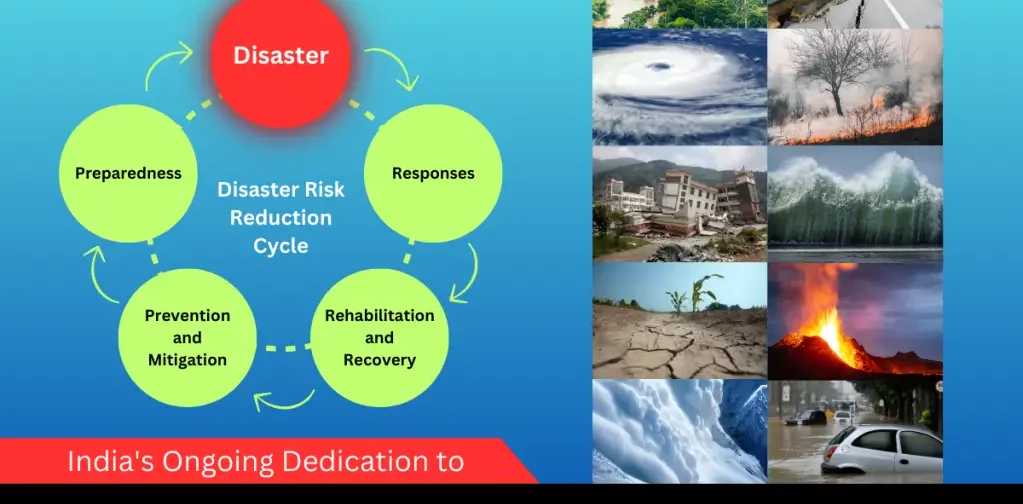
- Home
- About
- Knowledge Center
- Legislative Landscape
- Resources
- #TOGETHERFORBHARA
The International Day for Natural Disaster Reduction serves as a symbol of unity in a world where natural disasters are posing increasing problems. Its historical roots extend back to 1989 when the UN General Assembly, in a prescient move, designated this day as part of the International Decade for Natural Disaster Reduction. This observance holds special importance and relevance for the Indian context, given the nation’s history of dealing with natural disasters. Let us explore India’s historical encounters with disasters, and the recent initiatives in disaster management in a changing climate scenario.
India’s history is deeply intertwined with the challenges posed by natural disasters. From ancient times, the Indian subcontinent has faced a wide array of natural calamities, including floods, earthquakes, cyclones, and droughts. This historical context is evident in ancient texts such as Chanakya’s Arthashastra and the accounts of state administration from mythological times. These documents reveal the wisdom and resilience of India’s ancestors in dealing with natural disasters. So, for India, it is a day to celebrate its ancient wisdom and modern efforts in confronting the age-old challenges posed by natural disasters. It underscores the nation’s resolve to continue working towards building a safer and more resilient future, not only for its people but for all nations facing the ever-present threat of natural calamities.
Recently at the G20 Summit, The Disaster Risk Reduction Working Group (DRRWG) was launched by the Indian Presidency in December 2022. The Brazilian Presidency will take forward the DRRWG in December 2023.
The five priority areas of the DRRWG are – 1) Global Coverage of Early Warning Systems, 2) Disaster and Climate Resilient Infrastructure, 3) Financing Framework for Disaster Risk Reduction, 4) Disaster Response System, and 5) Ecosystem-based Approach to Disaster Risk Reduction.
The members agreed on accelerating their efforts to enhance universal coverage of multi-hazard early warning systems and transforming them into early action. They will foster collaborations between different stakeholders to build capacities to support anticipatory action and promote pre-arranged financing so that early action saves lives and livelihoods.
Members also emphasized the need for investments in disaster and climate-resilient infrastructure, with a focus on G20 Principles for Quality Infrastructure Investment. They recognized the need to strengthen public-private partnerships, blended finance mechanisms, and governance systems for resilient and interconnected infrastructure projects.
In 2022, India experienced a staggering 2.5 million internal displacements caused by natural disasters, according to Global Report on Internal Displacement (GRID). This grim statistic is part of a larger pattern in South Asia, where a collective total of 12.5 million people were internally displaced due to disasters during the same year. Among the most severely affected countries in the region were Pakistan, India, and Bangladesh.1
As heavy rains and landslides continue to cause havoc in India’s hill states, it’s essential to recognize that concerns about these vulnerable regions have already been raised in a 2019 strategy document published by the National Disaster Management Authority (NDMA). This document shed light on a host of pressing issues, including poor urban planning, the lack of a comprehensive land use policy, weak enforcement of construction laws, and the adverse impacts of excessive tourism in these areas. One particularly alarming observation was the tendency to replicate building plans from the Delhi Master Plan in these hill states, a practice that may have contributed to their vulnerability to recent disasters.
However, there is hope on the horizon. Recently, the Union Ministry of Home Affairs, led by Shri. Amit Shah has taken significant steps to address these concerns and bolster disaster preparedness. They have launched a “Scheme for Expansion and Modernization of Fire Services in the States” from the earmarked allocation of the Preparedness and Capacity Building Funding Window under the National Disaster Response Fund (NDRF). This scheme, with a total outlay of Rs. 5,000 crore, aims to strengthen fire services in the states, which play a crucial role in disaster response.
Furthermore, during a meeting chaired by the Union Home Minister, three schemes with a combined allocation of ₹8,000 crore were announced. These schemes target various aspects of disaster management.
During this meeting, emphasis was placed on proactive disaster response, collective responsibility, and the importance of building on past achievements. Various topics, including nuclear safety, early warning systems, and strengthening disaster authorities, were discussed in collaboration with state representatives.
These initiatives reflect a commitment to enhancing disaster preparedness and response capabilities, addressing the concerns previously highlighted in the 2019 NDMA document, and ultimately ensuring the safety and resilience of vulnerable regions, especially in the face of natural disasters.
In India, the observance of this day serves as a poignant reminder of the nation’s enduring commitment to disaster management. With its vast population, diverse geography, and susceptibility to a range of natural hazards, India has been at the forefront of implementing measures to protect lives, homes, and essential facilities. The International Day for Natural Disaster Reduction provides an annual platform for India to showcase its dedication to education, preparedness, and cooperation in disaster risk reduction.
